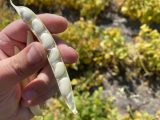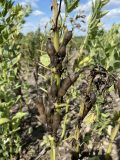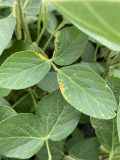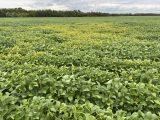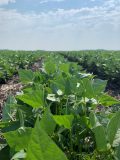 August 18, 2021
August 18, 2021
- Crop and Scouting Updates
- Drought Impact on Soybeans
- Dry Bean Desiccation
- 2021 Soybean Disease Survey
- Soybean and Dry Bean Yield Estimates
- Potassium Deficiency in Soybeans
- On-Farm Network Update: Visual Differences in Dry Bean Tillage Trials
Listen to The Bean Report:
Crop Update
- Soybeans are mainly at the R6 (full seed) stage right now in Manitoba. The most advanced crops are approaching R7 (beginning maturity) with yellowing of lower leaves, leaf drop and pod colour change.
- Dry beans range from R8 (early maturity) to R8.5 (mid-maturity). At these stages, lower leaves are turning yellow, leaf drop has begun and seeds are showing their true bean colours
- Field peas in have nearly all been harvested, except for a few mature crops that are waiting for the combine.
- Faba beans that received better moisture throughout the season range are at R6 (beginning maturity) and harvest has begun for those in drier regions.
Scouting Update
- We are seeing fewer four-bean pods in soybeans and fewer seven- to eight-bean pods in dry beans. However, early yield estimates are looking good in the stronger areas of some fields.
- Symptoms of potassium (K) deficiency are showing up in soybean and dry bean crops, in some cases severely, as the pod demand for K has increased.
- Continue to monitor grasshopper pressure as they move from harvested crops into greener crops nearby. If you are considering insecticidal control, ensure it will be economical and check the preharvest interval (PHI) of different products.
- Matador/Silencer/Labamba – PHI of 21 days in soybeans, Decis – PHI of 7 days in dry beans and faba beans, Coragen – PHI of 1 day in soybeans, dry beans and faba beans.
- Twospotted spider mites and soybean aphids no longer pose a threat to soybean crops at the R6 stage.
- Pea aphids and lygus bugs can be found in faba bean crops. It is past the stage for pea aphid control, but lygus bugs can continue to cause damage until seeds are firm.
- In dry bean crops, bacterial blight can commonly be found, along with late-season weeds that may pose an issue at harvest time.
- Chocolate spot and Stemphylium blight (which are visibly indistinguishable from one another) are commonly found in faba bean crops, despite the dry conditions.
Drought Impact on Soybeans
 This is the first time most soybean growers have experienced a full season of drought in Manitoba. We have come to know what to expect from crops like wheat and canola under these conditions, but we are still rounding out some unknowns with soybeans. This season, we started off with dry soils from the previous year, experienced a serious lack of rain at most locations (far below the 16-20 inches of water a soybean crop needs throughout the growing season) and saw 16 days in July that were above 30ׄ°C.
This is the first time most soybean growers have experienced a full season of drought in Manitoba. We have come to know what to expect from crops like wheat and canola under these conditions, but we are still rounding out some unknowns with soybeans. This season, we started off with dry soils from the previous year, experienced a serious lack of rain at most locations (far below the 16-20 inches of water a soybean crop needs throughout the growing season) and saw 16 days in July that were above 30ׄ°C.
Plants have responded to the water deficit by reducing their height (shortened internode length), reducing leaf area, and moving through development stages very quickly, on the road to early maturity. However, they likely put extra resources into greater rooting depth to access water. Drought can also reduce nitrogen fixation, but we have seen lots of large root nodules this season which are reported to be more resilient to drought stress. In response to heat, plants frequently flipped their leaves to reflect solar radiation and closed their stomata for extended periods of time, resulting in less photosynthesis and less sugar for growth and yield development.
Peak water uptake for soybeans is at flowering (R1), but the most critical times for water uptake are at pod initiation (R3) and seed fill (R5-R6). Over the last couple of weeks, we have seen shrunken seeds and yellow or dried up pods in the drought stressed fields.
Unfortunately, a lot of damage had already been done, but last week’s rains certainly helped soybean crops that were still at the R5 stage. Research has found that each 1 mm of moisture during seed-filling can amount to 0.19 bu.
Dry Bean Desiccation
The correct timing for dry bean desiccation is at R9 (full maturity), when there is 80% pod colour change, 80-90% leaf drop and <30% seed moisture in the least mature parts of the field. At <30% seed moisture, seeds will rattle within the lowest pods, upper pods will be yellow and the seeds within the upper pods will have lost their green colour when split. To help you out with your desiccation decisions, we have a brand new Dry Bean Desiccation and Harvest Guide.
Consult with your buyer about the best product options and potential product limitations. Most bean dealers are no longer accepting pre-harvest glyphosate on dry beans.
2021 Soybean Disease Survey
Each year, MPSG agronomists take part in the soybean disease survey led by Agriculture and Agri-Food Canada and Manitoba Agriculture and Rural Development. This survey took place from late July to early August at the R4-R5 stages.
What does this survey provide?
- Root rot results from roots samples that are collected by surveyors and later tested in-lab at AAFC.
- Severity ratings of foliar diseases, including bacterial blight, Septoria brown spot and downy mildew, along with information on how many fields across the province have the disease (prevalence) and how many plants are infected within fields (incidence).
- Prevalence and incidence of stem diseases, like northern stem canker, white mould, Phytophthora root and stem rot.
- A watchful eye for the less common diseases (e.g., soybean cyst nematode) or those that have not yet been detected in Manitoba (e.g., brown stem rot).
Preliminary 2021 results
- Very low levels of the two most common diseases, bacterial blight (greater severity in fields with previous hail damage) and Septoria brown spot (worse on fields with tight soybean rotations).
- Only trace amounts of frogeye leaf spot. No downy mildew. Suspected Alternaria leaf blight.
- Little to no Phytophthora and northern stem canker (present in fields with previously high disease pressure), and no white mould or other significant stem diseases.
- No additional cases of SCN, nor new soybean pathogens.
Where to find the detailed, regional results?
Each year, the results are summarized in MPSG’s Pulse Beat magazine and made available at manitobapulse.ca.
Soybean and Dry Bean Yield Estimates
Once beans reach or surpass the full seed stage (R6 for soybeans, R7 for dry beans), yields may be estimated. For soybeans, the Bean App has a yield estimator tool that will do the calculations for you. For edible beans, use the calculation below.
Yield estimates are only as good as the number of counts taken. Yields are highly variable within fields, so increasing the number of counts and taking counts from different areas can improve the accuracy of estimates.
Yield (lbs/ac) = plants/acre x pods/plant x seeds/pod ÷ seed size (seeds/lb)
(for soybeans divide yield by 60 for bu/ac)
First, estimate the average plant population in the field by taking plant stand counts. Then, in several areas, count and average the number of pods per plant. Within those pods, count and average the number of seeds per pod. Then, estimate the seed size (seeds per lb) – use the seed size of your variety and increase that value slightly to account for environmental conditions. Challenging dry conditions will likely result in smaller seeds, and thus more seeds per lb.
Potassium Deficiency in Soybeans
Patches of potassium (K) deficiency are showing up in soybeans grown on sandier soils as soybeans fill pods. Symptoms are chlorosis of the leaf margins as soybeans are moving K from the leaves to the seeds. Sandy soils are often low in K, resulting in the deficiency symptoms.
Soybeans have not consistently responded to K fertilizer treatments at low-K sites, according to research in Manitoba. However, soybeans remove large amounts of K in the seed (1.1 – 1.4 lbs K2O/bu), so it is important to balance K fertility throughout the rotation to support yields of other crops.
Visual Differences in Dry Bean Tillage Trials
The OFN began investigating tillage strategies for dry beans in 2020, comparing strip-till and conventional till in pinto beans. While the 2020 trial didn’t reveal significant yield differences between tillage practices, there were obvious benefits from reduced tillage mitigating the harsh effects of spring sandblasting.
This season, the OFN is hosting two strip-till vs. conventional till trials – one in pinto beans and the other in black beans. The persistent dry conditions this season certainly lend themselves to observing visual differences between strip-till and conventional till plots in both bean types. There is a notable vigour difference, with strip-till beans visually appearing heartier than adjacent conventional till beans. Additionally, in the pinto bean trial, there is more weed pressure in conventional tilled strips compared to strip-till strips. The OFN team is excited to see how these visual differences play out in yield at harvest!







